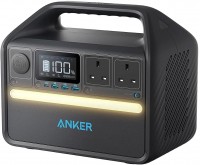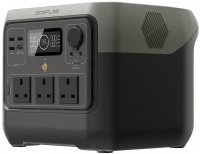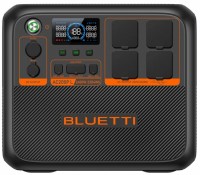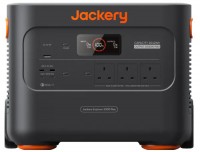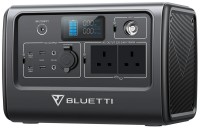Portable Power Stations EcoFlow
All models Advanced filters → |
You might be interested in
Articles, reviews, useful tips
All materials
How to choose a charging station
Everything you need to know about power, capacity and type of battery, as well as other criteria for choosing charging stations

How to choose powerbank: tips, tricks and useful life hacks
Detailed guide on choosing powerbank battery for different application purposes

Internet without light: GPON technology
What is GPON technology and how to use the Internet without electricity?

Common battery types
Pros and cons of common types of batteries

How to choose a solar panel
We choose reliable solar panels with high efficiency over many years and a minimum payback period

How to choose UPS
Methods for choosing UPS for boiler, computer, refrigerator and other equipment
Portable Power Stations: specifications, types
Show all
In box
- Charging station. Portable charging stations are powerful “power banks” that can establish autonomous operation of an arsenal of home appliances, organize the supply of electricity in the country, during road trips or forays into nature, and charge many mobile phones overnight. Charging stations differ from traditional UPSs in their automatic operating modes. The power of such devices varies widely from approximately 100 to 3600 W. Mobile stations are charged from a regular household outlet, solar panels, car cigarette lighter socket, generator, or via a USB type C port with Power Delivery support. As for the configuration, the charging station can be supplied either by itself or additionally with a solar panel, battery pack, inverter or inverter and solar panel. In addition to the built-in battery of the charging station, you can also purchase a battery pack separately.
— Battery pack. An additional battery pack to increase the total energy capacity of the charging station and, as a result, extend the period of autonomous power supply to consumers. Often, battery packs are produced for a specific model or family of charging stations in accordance with the dimensions of the device. Their design, as a rule, is stacked: a block with an additional battery is connected to the charging station f...rom below or from the side.
— Charging station with battery pack. The standard configuration of such charging stations includes an additional battery pack, which allows you to increase the energy intensity of the device. Note that, if necessary, the additional battery can be easily detached from the charging station and it can be used without an external battery.
— Charging station with solar panel. Charging stations with a complete solar panel suggest the possibility of replenishing energy reserves in battery cells from the celestial body. Out of the box, they come with a folding solar panel that can be deployed on a sunny lawn and charge the device when there is no electricity in the outlet. Depending on the power of the charging station and solar panel, as well as weather conditions and daylight hours, the charging procedure can last from several hours to a full daylight hours (or even more).
- With an inverter. The delivery set of such charging stations includes an inverter, which is used to convert direct power energy from solar panels into alternating power for domestic needs. Note that in this case it is assumed that there is only one inverter - solar panels for charging a portable power station from the rays of the heavenly body will need to be purchased separately. Charging stations with an inverter and a solar panel are also available (see below).
— With inverter and solar panel. Advanced configuration, which implies the presence of a charging station, one or more solar panels and an inverter for converting energy from them. In this form, the portable power station impresses with its energy independence - it can be charged directly from the sun’s rays, even during a long absence of electricity in the outlets, and the charging station is ready for this right out of the box.
— Battery pack. An additional battery pack to increase the total energy capacity of the charging station and, as a result, extend the period of autonomous power supply to consumers. Often, battery packs are produced for a specific model or family of charging stations in accordance with the dimensions of the device. Their design, as a rule, is stacked: a block with an additional battery is connected to the charging station f...rom below or from the side.
— Charging station with battery pack. The standard configuration of such charging stations includes an additional battery pack, which allows you to increase the energy intensity of the device. Note that, if necessary, the additional battery can be easily detached from the charging station and it can be used without an external battery.
— Charging station with solar panel. Charging stations with a complete solar panel suggest the possibility of replenishing energy reserves in battery cells from the celestial body. Out of the box, they come with a folding solar panel that can be deployed on a sunny lawn and charge the device when there is no electricity in the outlet. Depending on the power of the charging station and solar panel, as well as weather conditions and daylight hours, the charging procedure can last from several hours to a full daylight hours (or even more).
- With an inverter. The delivery set of such charging stations includes an inverter, which is used to convert direct power energy from solar panels into alternating power for domestic needs. Note that in this case it is assumed that there is only one inverter - solar panels for charging a portable power station from the rays of the heavenly body will need to be purchased separately. Charging stations with an inverter and a solar panel are also available (see below).
— With inverter and solar panel. Advanced configuration, which implies the presence of a charging station, one or more solar panels and an inverter for converting energy from them. In this form, the portable power station impresses with its energy independence - it can be charged directly from the sun’s rays, even during a long absence of electricity in the outlets, and the charging station is ready for this right out of the box.
Rated power
Power that a device can consistently produce for an indefinitely long time without any unpleasant consequences. For normal operation of the charging station, the rated power must be at least 15 - 20% higher than the total power of all devices simultaneously connected to it.
Peak power
Some electrical appliances (in particular, units with electric motors - refrigerators, air conditioners, etc.) consume significantly more energy at startup than after reaching the operating mode. For such a load, the peak power of the charging station must be taken into account - its indicator must be higher than the starting power of the load.
Output waveform
Line shape on a graph of the voltage output from a charging station. The quality of power provided by the device depends on this parameter.
— Sine wave (PSW — Pure Sine Wave). The signal is in the form of a smooth wave without sharp steps, maximally corresponding to the parameters of conventional AC networks. Charging stations with this output signal form can be used for almost any type of load, incl. for powering sensitive electronics that place high demands on the quality of the input voltage.
— Modified sine wave. In a signal similar to a sine wave, the waves on the graph are formed not by smooth lines, but by characteristic “steps” (i.e., jerks). An approximated sine wave is not suitable for powering sensitive electronics, but in general there are not so many such devices in the total number, and circuits with a modified sine wave do not require the creation of expensive and complex technical solutions. As a result, they are cheaper.
— Sine wave (PSW — Pure Sine Wave). The signal is in the form of a smooth wave without sharp steps, maximally corresponding to the parameters of conventional AC networks. Charging stations with this output signal form can be used for almost any type of load, incl. for powering sensitive electronics that place high demands on the quality of the input voltage.
— Modified sine wave. In a signal similar to a sine wave, the waves on the graph are formed not by smooth lines, but by characteristic “steps” (i.e., jerks). An approximated sine wave is not suitable for powering sensitive electronics, but in general there are not so many such devices in the total number, and circuits with a modified sine wave do not require the creation of expensive and complex technical solutions. As a result, they are cheaper.
UPS function
Charging stations with UPS function switch consumers to backup power from their own battery, acting as an uninterruptible power supply. In comparison with full-fledged UPSs, switching does not occur instantly, but with a certain delay (about 10-30 ms). To use this function correctly, you must first study the instructions for the charging station, which often describes the correct procedure for connecting the intended consumer devices.
Sockets (230 V)
Total number of outlets with output voltage. This is, in fact, the number of devices that can be simultaneously connected to the charging station without the use of splitters, extension cords and carriers. Accordingly, weaker charging stations have one or two sockets in their submission. Powerful charging stations already have three or more sockets “on board”.
USB A
Full-size USB A connectors are popular in computer technology, they are standardly used in adapter chargers for 230 V household networks and 12 V auto sockets. In charging stations, such outlets are widely used for charging gadgets.
- The total number of such ports can be very diverse ( 1 USB, 2 connectors, 3 ports and even 4), since it allows you to connect for charging, and in some cases for power, various low-power devices - smartphones, tablets, power banks, lamps, etc. .
- The strength of the power. The maximum power output through the USB A connector to the device being charged. Note that different ports of the charging station can output different power (for example, 1.5 A and 2.1 A). In this case, the highest power strength is usually indicated.
— Power. The maximum output power in watts (W) that the charging station is capable of delivering through the USB A connector to one charging device.
- The total number of such ports can be very diverse ( 1 USB, 2 connectors, 3 ports and even 4), since it allows you to connect for charging, and in some cases for power, various low-power devices - smartphones, tablets, power banks, lamps, etc. .
- The strength of the power. The maximum power output through the USB A connector to the device being charged. Note that different ports of the charging station can output different power (for example, 1.5 A and 2.1 A). In this case, the highest power strength is usually indicated.
— Power. The maximum output power in watts (W) that the charging station is capable of delivering through the USB A connector to one charging device.
USB A (quick charge)
Full size USB A ports with fast charging support. It allows you to charge your smartphone, tablet or other connected device much faster. The charging process takes place at increased power, and the current and voltage at each stage are regulated in such a way as to remain within the optimal values. However, it should be borne in mind that in our time there are many fast charging technologies and not all of them are compatible with each other.
- The strength of the current. The parameters of the current issued through the USB A fast charging connectors. Note that different voltage and current parameters can be output to different ports of the charging station. This item specifies the current values at a certain voltage (for example, 5 V / 3 A, 9 V / 2 A, 12 V / 1.5 A).
— Power. The maximum power in watts (W) that the charging station is capable of delivering through the USB A fast charging connector to one charging device. High output power allows you to speed up the charging process. However, the appropriate power must be supported by the device being charged - otherwise the speed of the process will be limited by the characteristics of the gadget.
- The strength of the current. The parameters of the current issued through the USB A fast charging connectors. Note that different voltage and current parameters can be output to different ports of the charging station. This item specifies the current values at a certain voltage (for example, 5 V / 3 A, 9 V / 2 A, 12 V / 1.5 A).
— Power. The maximum power in watts (W) that the charging station is capable of delivering through the USB A fast charging connector to one charging device. High output power allows you to speed up the charging process. However, the appropriate power must be supported by the device being charged - otherwise the speed of the process will be limited by the characteristics of the gadget.
USB type C
USB type C ports are smaller than classic USBs, and they also have a convenient reversible design that allows you to connect the plug in either direction. USB type C was originally designed to be able to implement various advanced features: increased power supply, fast charging technologies, etc.
Since the port is relatively new and quite powerful (there are USB type C with a power of 60 W and even 100 W), the total number of such connectors is often limited to 1 port, less often two).
- The strength of the power. The maximum power output through the USB type C connector to a charging device. Note that different ports of the charging station can output different power (for example, 1.5 A and 2.1 A). In this case, the highest power strength is usually indicated.
— Power. The maximum power in watts (W) that the charging station is capable of delivering to one rechargeable gadget. The high output power of the USB type C port allows you to speed up the charging process. However, the appropriate power must be supported by the device being charged - otherwise the speed of the process will be limited by the characteristics of the gadget.
Since the port is relatively new and quite powerful (there are USB type C with a power of 60 W and even 100 W), the total number of such connectors is often limited to 1 port, less often two).
- The strength of the power. The maximum power output through the USB type C connector to a charging device. Note that different ports of the charging station can output different power (for example, 1.5 A and 2.1 A). In this case, the highest power strength is usually indicated.
— Power. The maximum power in watts (W) that the charging station is capable of delivering to one rechargeable gadget. The high output power of the USB type C port allows you to speed up the charging process. However, the appropriate power must be supported by the device being charged - otherwise the speed of the process will be limited by the characteristics of the gadget.
Wireless charger
In wireless charging mode, energy is transferred to the gadget being charged through an inductive surface, which is usually built into the upper plane of the charging station case. There can be one slot for wireless charging or several of them are provided. The range of this technology does not exceed a few centimeters. However, this method of charging eliminates the fuss with wires and reduces wear on the connectors. One of the key disadvantages of this format is considered to be low power and, accordingly, slow charging speed.
Car cigarette lighter
Built-in cigarette lighter socket with 12 V output voltage in the design of the charging station. Such an interface is in fact a standard "car socket" used to connect various devices to the car's on-board network. The presence of a cigarette lighter socket (car outlet) allows you to use the charging station as a power source for such devices. The number of sockets in different models can be different - most often there is one cigarette lighter, but occasionally there are options for a couple of connectors.
DC output
The presence of a DC connector (or several such outputs) in the device to power external gadgets with direct current. The standard DC jack is round and has a pin in the center. However, its dimensions may differ in depth and diameter. The voltage output to the DC output may be different. The most popular options are 18 - 20 V for powering laptops, 12 V for various specialized devices and automotive electrical accessories.
Add. ports
Additional output connectors provided in the design of the charging station in addition to those described above.
From solar panels
The ability to charge the device from solar panels ensures the energy independence of a portable power plant. Models with this function can work completely autonomously and do not depend on outlets. Charging from the panels is implemented in the corresponding devices with portable solar panels and charging stations, which are structurally provided with specialized connectors for receiving power from stationary solar panels, and there is also a built-in MPPT charge controller (Maximum Power Point Tracking).
From USB type C port
The ability to replenish energy reserves in the battery cells of the charging station via the USB type C connector. This port itself is small in size and has a convenient double-sided design, thanks to which the plug can be inserted in either direction. However, in charging stations it does not always work as an input interface.
DC input
DC connector for a distinctive round plug (like those used in many laptops) used to recharge the battery of the device. Note that DC- in plugs may have different sizes, and chargers with such plugs may have different operating voltages. In practice, this leads to the fact that finding a suitable charger for a portable station is not easy, you need to be especially careful when searching.
Input port XT60
Power connector with two round connectors, used to replenish energy reserves in the battery cells of the charging station. For the most part, the input port of the XT60 is for charging the device from solar panels using the appropriate cable.
Anderson port
A large two-pole connector for connecting batteries, chargers and all kinds of equipment where reliable contact is required for the sake of ensuring stable operation of the equipment. Anderson Port is resistant to moisture changes, can be used both for indoor and outdoor mechanisms. Thanks to identical mating parts, a pair is formed by two identical connectors, which are rotated 180 ° relative to each other. Most often, Anderson port is used in mobile homes on wheels.
Add. ports
Additional input connectors provided in the design of the charging station in addition to those described above.
Connecting an additional battery
Ability to connect an external battery to the charging station to increase the overall energy consumption and, as a result, extend the battery life. This connection is fast and convenient. On the other hand, the battery takes up extra space on the outside, making the whole structure more cumbersome.
Battery type
— Li-Ion. The key advantage of lithium-ion batteries is their high capacity with small dimensions and weight. Also, Li-Ion batteries are not subject to memory effect and can charge quite quickly. Of course, this option is not without its drawbacks - first of all, it is sensitivity to low or elevated temperatures, and if overloaded, the lithium-ion battery can catch fire or even explode. However, thanks to the use of built-in controllers, the likelihood of such “accidents” is extremely low and, in general, the advantages of this technology significantly outweigh the disadvantages.
— Li-Pol. An improved version of lithium-ion technology (see the corresponding paragraph): the liquid electrolyte in Li-Pol batteries is replaced with a solid polymer. At the same high capacity, the batteries have become more compact, there is practically no “memory effect” in them, and the likelihood of fires and explosions in the event of critical violations of operating conditions is minimized. The downside of these improvements was increased cost and increased sensitivity to frost. However, most often these shortcomings are not significant.
— LiFePO4. Lithium iron phosphate batteries are a modification of lithium ion batteries (see corresponding paragraph) designed to eliminate some of the shortcomings of the original technology. LiFePO4 batteries are characterized by a...large number of charge/discharge cycles, chemical and thermal stability, low temperature tolerance, short charging time (including high currents) and safety in operation. The likelihood of an “explosion” of a LiFePO4 battery when overloaded is reduced to almost zero, and in general, such batteries cope with high peak loads without problems and maintain the operating voltage almost until discharge.
— Li-Ion NMC. A type of lithium rechargeable battery using a complex alloy in the manufacture of the cathode. It contains nickel, manganese and cadmium. This “recipe” allows you to increase the power of a power source based on Li-Ion NMC elements. Batteries of this type have a high specific capacity and a stable discharge voltage, provide a long operating time of the charging station with high performance, are characterized by a complete absence of “memory effect”, maintain functionality over a wide temperature range and are fireproof.
— VRLA. Acid batteries with a regulating safety valve to release excess gas. The abbreviation VRLA stands for Valve Regulated Lead Acid. Batteries of this type have a sealed, non-separable design and come in two types: AGM VRLA (the battery plates are equipped with a layer of fiberglass absorbent) and GEL VRLA (with a gel electrolyte in a jelly-like state). Batteries with a control valve are resistant to deep discharges, do not require topping up with distillate throughout their entire service life, and do not emit hydrogen or oxygen.
- Semi-solid State. An advanced type of lithium-ion battery (see above), which combines some of the characteristics of liquid and solid batteries. It uses an electrolyte that is in a semi-soft or gel-like state, making the batteries more resistant to leakage than traditional wet batteries. Semi-solid state technology allows for a significant increase in the energy density of cells. As a result, it is possible to make compact batteries with high energy intensity.
— Li-Pol. An improved version of lithium-ion technology (see the corresponding paragraph): the liquid electrolyte in Li-Pol batteries is replaced with a solid polymer. At the same high capacity, the batteries have become more compact, there is practically no “memory effect” in them, and the likelihood of fires and explosions in the event of critical violations of operating conditions is minimized. The downside of these improvements was increased cost and increased sensitivity to frost. However, most often these shortcomings are not significant.
— LiFePO4. Lithium iron phosphate batteries are a modification of lithium ion batteries (see corresponding paragraph) designed to eliminate some of the shortcomings of the original technology. LiFePO4 batteries are characterized by a...large number of charge/discharge cycles, chemical and thermal stability, low temperature tolerance, short charging time (including high currents) and safety in operation. The likelihood of an “explosion” of a LiFePO4 battery when overloaded is reduced to almost zero, and in general, such batteries cope with high peak loads without problems and maintain the operating voltage almost until discharge.
— Li-Ion NMC. A type of lithium rechargeable battery using a complex alloy in the manufacture of the cathode. It contains nickel, manganese and cadmium. This “recipe” allows you to increase the power of a power source based on Li-Ion NMC elements. Batteries of this type have a high specific capacity and a stable discharge voltage, provide a long operating time of the charging station with high performance, are characterized by a complete absence of “memory effect”, maintain functionality over a wide temperature range and are fireproof.
— VRLA. Acid batteries with a regulating safety valve to release excess gas. The abbreviation VRLA stands for Valve Regulated Lead Acid. Batteries of this type have a sealed, non-separable design and come in two types: AGM VRLA (the battery plates are equipped with a layer of fiberglass absorbent) and GEL VRLA (with a gel electrolyte in a jelly-like state). Batteries with a control valve are resistant to deep discharges, do not require topping up with distillate throughout their entire service life, and do not emit hydrogen or oxygen.
- Semi-solid State. An advanced type of lithium-ion battery (see above), which combines some of the characteristics of liquid and solid batteries. It uses an electrolyte that is in a semi-soft or gel-like state, making the batteries more resistant to leakage than traditional wet batteries. Semi-solid state technology allows for a significant increase in the energy density of cells. As a result, it is possible to make compact batteries with high energy intensity.
Battery capacity
Nominal battery capacity, in fact - the amount of energy that is supposed to be stored. The larger it is, the longer the battery life of the charging station will be, all other things being equal. On the other hand, this parameter also affects the dimensions, weight and price of the battery, despite the fact that an energy-intensive battery is not always required. By the indicator of capacity in watt-hours, you can compare batteries with each other.
Charging cycles
The number of charge-discharge cycles that the battery can withstand without significant loss of performance.
In the process of operation, the batteries wear out, which causes their performance to suffer (in the first place, the capacity decreases). Battery life is usually measured in charge-discharge cycles. However, models with the same declared resource are not always equally durable in practice. Different manufacturers may interpret “significant loss of performance” in different ways: for example, one brand indicates the resource up to a 20% decrease in capacity (DOD > 80%), another - up to a 60% decrease (DOD > 40%) Behind the abbreviation DOD worth decoding Depth of Discharge, i.e. discharge depth. Therefore, when choosing, it makes sense to focus not only on pure numbers, but also on other sources - test results, reviews, etc. Also note that battery life can be noticeably reduced if the operating conditions are violated (for example, in case of overheating or hypothermia).
In the process of operation, the batteries wear out, which causes their performance to suffer (in the first place, the capacity decreases). Battery life is usually measured in charge-discharge cycles. However, models with the same declared resource are not always equally durable in practice. Different manufacturers may interpret “significant loss of performance” in different ways: for example, one brand indicates the resource up to a 20% decrease in capacity (DOD > 80%), another - up to a 60% decrease (DOD > 40%) Behind the abbreviation DOD worth decoding Depth of Discharge, i.e. discharge depth. Therefore, when choosing, it makes sense to focus not only on pure numbers, but also on other sources - test results, reviews, etc. Also note that battery life can be noticeably reduced if the operating conditions are violated (for example, in case of overheating or hypothermia).
Charging time (socket) ≈
Time to charge the portable power station from a fully discharged state to 100% charge when using the power adapter from a household outlet. This refers to the original battery and standard charger.
Charging time (socket + solar panel) ≈
The parameter allows you to estimate the approximate battery charging time in the mode of combined connection of a portable power station - from a power outlet and a solar panel overnight. This method of replenishing energy reserves allows you to speed up the charging process.
Charging time (solar panel) ≈
Time spent on a full charge when using the original panel in bright sunlight. In cloudy weather, the charging time of the device from the solar panel can be strikingly different downwards.
Charging time (cigarette lighter) ≈
The time required to fully (from zero to 100%) charge the battery, provided that power is supplied to the charging station from the car's cigarette lighter socket (12 V).
Charging time (socket + USB type C PD) ≈
Combined power supply from a household outlet and through a USB type C connector with Power Delivery support significantly reduces the time required to fully charge the battery of the device. The corresponding function must be supported by the charging station.
Charging power (socket)
The power at which, in normal mode, the portable power station is charged from a household outlet when using the original power supply.
Charging power (solar panel)
The power provided when charging the device from the solar panel.
Charging power (cigarette lighter)
The power normally received by the charging station when connected from the car's cigarette lighter socket (12 V).
Charging power (socket + solar panel)
Charging power with a combined variant of power supply to the device - from the socket and the solar panel at the same time.
Charging power (socket + USB type C PD)
The charging power received by the device, provided that it is connected both from a wall outlet and via a USB type C connector with Power Delivery support overnight.
Solar panel power
Characteristics of the solar panel supplied with the charging station. Through its surface, it is possible to replenish the energy reserves in the cells of the battery of the charging station during the daytime, whether it is far from the electrical civilization, when there is no available socket or cigarette lighter socket at hand.
Power
The amount of electricity in watts that a solar panel produces. The panel must provide the declared number of watts during normal operation.
Efficiency
Percentage of the maximum solar panel power to the incident radiation power produced. The efficiency parameter allows you to determine how efficiently the panel PV module converts solar energy into direct electric current.
Dimensions
Dimensions of the attached (complete) solar panel in unfolded form.
Smartphone synchronization
Synchronization with a smartphone allows you to control the operation of the charging station remotely. Pairing the device with mobile gadgets is carried out via a Wi-Fi network or a Bluetooth connection. Some charging stations provide both of the above wireless modules. Additionally , synchronization with a smartphone allows you to monitor battery charge, energy consumption, voltage and current parameters remotely in real time. This will require a permanent connection to the Internet and specialized software that must be installed on your smartphone.
PSU
— External. Outdoor placement of the power supply requires additional space. However, most blocks of this type are quite compact in size and are equipped with “plugs” for sockets right on the case - in other words, the block is installed on a socket, and from there the wire stretches to the charging station. There are also external power supplies on the cable. Considering that you only need to connect the adapter while the device is charging, an external power supply is a very convenient solution.
- Internal. The built-in power supply does not take up space outside the charging station, however, it can increase the dimensions and weight of the device. The advantage of this arrangement is that the most common power wire goes from the housing to the socket, without additional equipment on it. At one end it is connected to the socket, the other end is connected to the input connector of the charging station.
- Internal. The built-in power supply does not take up space outside the charging station, however, it can increase the dimensions and weight of the device. The advantage of this arrangement is that the most common power wire goes from the housing to the socket, without additional equipment on it. At one end it is connected to the socket, the other end is connected to the input connector of the charging station.
Display
An external display in the design of the charging station is used to display service information: device operation mode, percentage of battery remaining, power of the connected load, voltage and current parameters, indication of wireless modules. We also note that the device displays the estimated battery life with a load on the display, based on the amount of energy consumed in real time. Some models of charging stations are equipped with touch screens that provide convenient operation of the device.
Backlight
The presence in the charging station of illumination by the type of flashlight. This feature will come in handy when using the device in low light conditions - at dusk and even in complete darkness. Illumination is implemented in different ways: in some models it is made in the form of a light diffuser, in others it has a directional beam that illuminates the space at a certain distance. Also, the backlight can have brightness control and different modes of operation (continuous light, flashing, SOS signal).
Wheels for transportation
The ability to transport the charging station in the manner of a trolley is much more convenient than carrying it in your hands, especially when the model is heavy. Transport wheels are usually equipped with large and dimensional charging stations. There can be either four wheels (in all corners of the equipment case) or two (only on one edge).
Carrying handle
The presence of a handle on the body, which makes it easy to move the device manually. The very essence of portable charging stations involves mobile use, so the vast majority of such equipment is equipped with a handle for easy carrying.
Operating temperature
The temperature range in which the charging station normally operates in normal mode. Exceeding the specified norms in any direction leads to a rapid discharge of the battery, its accelerated degradation and other unpleasant consequences.

